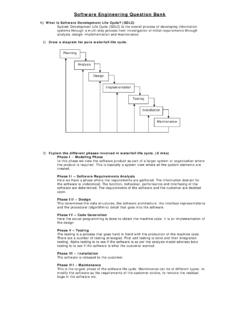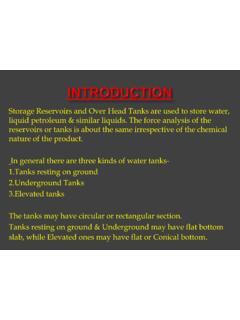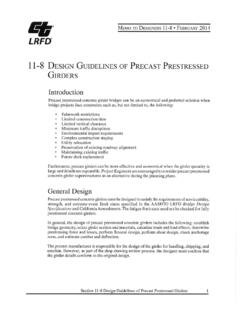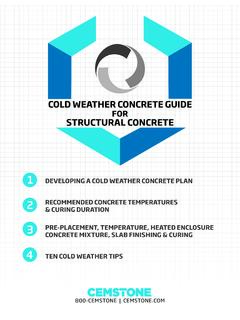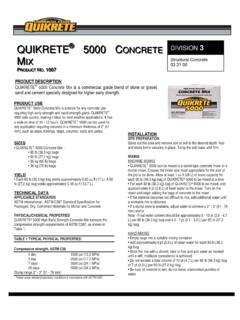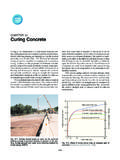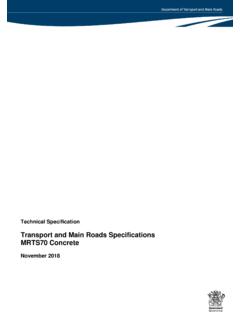Transcription of CEMENT CONCRETE MIX DESIGN - Dronacharya
1 CEMENT CONCRETE MIX DESIGNCEMENT CONCRETE MIX DESIGN DEFINITION The process of selecting suitable ingredients of CONCRETE and determining their relative quantities with the objective of producing a CONCRETE of the required strength , durability, and workability as economically as possible, is termed the CONCRETE mix DESIGN Mixes In the past the specifications for CONCRETE prescribed the proportions of CEMENT , fine and coarse aggregates. These mixes of fixed CEMENT -aggregate ratio which ensures adequate strength are termed nominal mixes. These offer simplicity and under normal circumstances, have a margin of strength above that specified. However, due to the variability of mix ingredients the nominal CONCRETE for a given workability varies widely in strength Types of Mixes Nominal mix CONCRETE Traditional way of mix proportion specified in terms of fixed ratios of CEMENT : Sand : coarse aggregate (In general by volume) 4 Useful for small works Useful for routine CONCRETE construction Limited up to M20 grade Requires high CEMENT content The nominal mixes of fixed CEMENT -aggregate ratio (by volume) vary widely in strength and may result in under- or over-rich mixes.
2 For this reason, the minimum compressive strength has been included in many specifications. These mixes are termed standard mixes. Standard mixes IS 456-2000 has designated the CONCRETE mixes into a number of grades as M10, M15, M20, M25, M30, M35 and M40. In this designation the letter M refers to the mix and the number to the specified 28 day cube strength of mix in N/mm2. The mixes of grades M10, M15, M20 and M25 correspond approximately to the mix proportions (1:3:6), (1:2:4), (1 :3) and (1:1:2) respectively. The proportions generally adopted are as given below 7 Grade of CONCRETE Nominal Mix proportions ( CEMENT : FA : CA) M 5 1:5:10 1:4:8 M10 1:3:6 M15 1:2:4 M20 1 :3 DESIGNED MIXES In these mixes the performance of the CONCRETE is specified by the designer but the mix proportions are determined by the producer of CONCRETE , except that the minimum CEMENT content can be laid down.
3 This is most rational approach to the selection of mix proportions with specific materials in mind possessing more or less unique characteristics. Several methods of mix DESIGN evolved over the years in different countries Ex: ACI practice, British practice, Indian Standard recommendations. etc. DESIGN MIX CONCRETE RECOMMENDATIONS FOR CONCRETE MIX DESIGN ARE GIVEN IN & Designed mix should meet the DESIGN requirements in the fresh and hardened states FACTORS AFFECTING THE CHOICE OF MIX PROPORTIONS The various factors affecting the mix DESIGN are: 1. compressive strength It is one of the most important properties of CONCRETE and influences many other describable properties of the hardened CONCRETE . The mean compressive strength required at a specific age, usually 28 days, determines the nominal water- CEMENT ratio of the mix.
4 The other factor affecting the strength of CONCRETE at a given age and cured at a prescribed temperature is the degree of compaction. According to Abraham s law the strength of fully compacted CONCRETE is inversely proportional to the water- CEMENT ratio. 2. Workability The degree of workability required depends on three factors. These are the size of the section to be concreted, the amount of reinforcement, and the method of compaction to be used. For the narrow and complicated section with numerous corners or inaccessible parts, the CONCRETE must have a high workability so that full compaction can be achieved with a reasonable amount of effort. This also applies to the embedded steel sections. The desired workability depends on the compacting equipment available at the site.
5 3. Durability The durability of CONCRETE is its resistance to the aggressive environmental conditions. High strength CONCRETE is generally more durable than low strength CONCRETE . In the situations when the high strength is not necessary but the conditions of exposure are such that high durability is vital, the durability requirement will determine the water- CEMENT ratio to be used. 4. Maximum nominal size of aggregate In general, larger the maximum size of aggregate, smaller is the CEMENT requirement for a particular water- CEMENT ratio, because the workability of CONCRETE increases with increase in maximum size of the aggregate. However, the compressive strength tends to increase with the decrease in size of aggregate. IS 456:2000 and IS 1343:1980 recommend that the nominal size of the aggregate should be as large as possible.
6 5. GRADING AND TYPE OF AGGREGATE The grading of aggregate influences the mix proportions for a specified workability and water- CEMENT ratio. Coarser the grading leaner will be mix which can be used. Very lean mix is not desirable since it does not contain enough finer material to make the CONCRETE cohesive. The type of aggregate influences strongly the aggregate- CEMENT ratio for the desired workability and stipulated water CEMENT ratio. An important feature of a satisfactory aggregate is the uniformity of the grading which can be achieved by mixing different size fractions. 6. QUALITY CONTROL The degree of control can be estimated statistically by the variations in test results. The variation in strength results from the variations in the properties of the mix ingredients and lack of control of accuracy in batching, mixing, placing, curing and testing.
7 The lower the difference between the mean and minimum strengths of the mix lower will be the CEMENT -content required. The factor controlling this difference is termed as quality control. MIX PROPORTION DESIGNATIONS The common method of expressing the proportions of ingredients of a CONCRETE mix is in the terms of parts or ratios of CEMENT , fine and coarse aggregates. For , a CONCRETE mix of proportions 1:2:4 means that CEMENT , fine and coarse aggregate are in the ratio 1:2:4 or the mix contains one part of CEMENT , two parts of fine aggregate and four parts of coarse aggregate. The proportions are either by volume or by mass. The water- CEMENT ratio is usually expressed in mass FACTORS TO BE CONSIDERED FOR MIX DESIGN The grade designation giving the characteristic strength requirement of CONCRETE .
8 The type of CEMENT influences the rate of development of compressive strength of CONCRETE . Maximum nominal size of aggregates to be used in CONCRETE may be as large as possible within the limits prescribed by IS 456:2000. The CEMENT content is to be limited from shrinkage, cracking and creep. The workability of CONCRETE for satisfactory placing and compaction is related to the size and shape of section, quantity and spacing of reinforcement and technique used for transportation, placing and compaction. I S CODE METHOD OF MIX DESIGN 19 PROCEDURE strength for mean strength The target mean compressive strength at 28 days (ft) =fck+ K = a statistical value , usually taken as S = standard deviation for each grade of CONCRETE ( table 8 of 456 -2000 ) 20 21 Values of K Accepted proportion of low results K 1 in 5, 20% 1 in 10, 10% 1 in 15, 1 in 20, 5% 1in 40, 1 in 100, 1% TABLE-8, IS CODE Grade of CONCRETE Assumed Standard , Deviations (N/mm ) M 10 ,M 15 M 20, M25 M 30, M 35, M 40, M 45 & M 50 22 23 A)
9 The free water CEMENT ratio corresponding to the target strength is to be determined from the graph shown in fig. of water CEMENT ratio : Modified graph for Selection of water CEMENT ratio : Exposure Plain CONCRETE Reinforced CONCRETE Min. CEMENT Max w/c Min grade Min. CEMENT Max w/c Min grade Mild 220 kg/m3 -- 300 kg/m3 M 20 Moderate 240 kg/m3 M 15 300 kg/m3 M 25 Severe 250 kg/m3 M 20 320 kg/m3 M 30 V. Severe 260 kg/m3 M 20 340 kg/m3 M 35 Extreme 280 M 25 360 M 40 B) The water CEMENT ratio, as selected above should be checked against the limiting water CEMENT ratio for the durability requirements as given in table Durability Criteria as per IS 456- 2000 Adjustments to minimum CEMENT content for aggregates other than 20 mm nominal max.
10 Size aggregates as per IS 456: 2000. 10 mm + 40 kg/cum 20 mm 0 40 mm - 30 kg/cum Placing condition Degree Slump (mm) Compaction factor Mass CONCRETE , lightly reinforced sections in beams, walls, columns and floors LOW 25 to 75 to Heavily reinforced sections in slabs, beams, walls, columns and footings MEDIUM 50 to 100 to Slip formwork, pumped CONCRETE , in- situ piling HIGH 100 to 150 to 28 Approximate water content (Kg) per cubic metre of CONCRETE (Table 32, SP:23-1982) Slump (mm) Maximum Size of Aggregate (mm) 10 20 40 30-50 205 185 160 80-100 225 200 175 150-180 240 210 185 of entrapped air Depends on nominal max size of aggregate as given in table 29 Max. size of aggregate (mm) Entrapped air as % of volume of CONCRETE 10 20 40 4.
